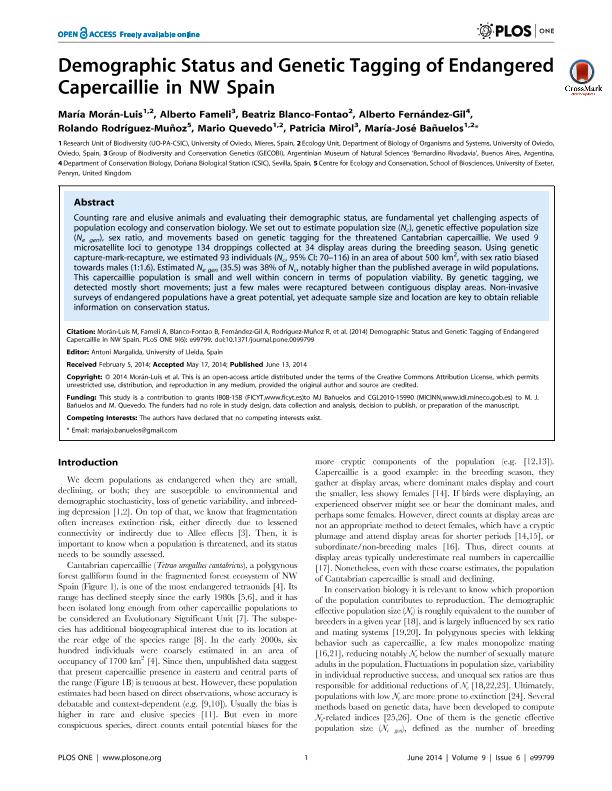Artículo
Demographic status and genetic tagging of endangered Capercaillie in NW Spain
Morán Luis, María; Fameli, Alberto Francisco ; Blanco Fontao, Beatriz; Fernández Gil, Alberto; Rodríguez Muñoz, Rolando; Quevedo, Mario; Mirol, Patricia Monica
; Blanco Fontao, Beatriz; Fernández Gil, Alberto; Rodríguez Muñoz, Rolando; Quevedo, Mario; Mirol, Patricia Monica ; Bañuelos, María José
; Bañuelos, María José
 ; Blanco Fontao, Beatriz; Fernández Gil, Alberto; Rodríguez Muñoz, Rolando; Quevedo, Mario; Mirol, Patricia Monica
; Blanco Fontao, Beatriz; Fernández Gil, Alberto; Rodríguez Muñoz, Rolando; Quevedo, Mario; Mirol, Patricia Monica ; Bañuelos, María José
; Bañuelos, María José
Fecha de publicación:
06/2014
Editorial:
Public Library of Science
Revista:
Plos One
ISSN:
1932-6203
Idioma:
Inglés
Tipo de recurso:
Artículo publicado
Clasificación temática:
Resumen
Counting rare and elusive animals and evaluating their demographic status, are fundamental yet challenging aspects of population ecology and conservation biology. We set out to estimate population size (Nc), genetic effective population size (Ne gen), sex ratio, and movements based on genetic tagging for the threatened Cantabrian capercaillie. We used 9 microsatellite loci to genotype 134 droppings collected at 34 display areas during the breeding season. Using genetic capture-mark-recapture, we estimated 93 individuals (Nc, 95% CI: 70-116) in an area of about 500 km 2, with sex ratio biased towards males (1:1.6). Estimated N e gen (35.5) was 38% of Nc, notably higher than the published average in wild populations. This capercaillie population is small and well within concern in terms of population viability. By genetic tagging, we detected mostly short movements; just a few males were recaptured between contiguous display areas. Non-invasive surveys of endangered populations have a great potential, yet adequate sample size and location are key to obtain reliable information on conservation status.
Palabras clave:
genetic tagging
,
capercaillie
,
conservation
Archivos asociados
Licencia
Identificadores
Colecciones
Articulos(MACNBR)
Articulos de MUSEO ARG.DE CS.NAT "BERNARDINO RIVADAVIA"
Articulos de MUSEO ARG.DE CS.NAT "BERNARDINO RIVADAVIA"
Citación
Morán Luis, María; Fameli, Alberto Francisco; Blanco Fontao, Beatriz; Fernández Gil, Alberto; Rodríguez Muñoz, Rolando; et al.; Demographic status and genetic tagging of endangered Capercaillie in NW Spain; Public Library of Science; Plos One; 9; 6; 6-2014; 1-9; e99799
Compartir
Altmétricas



